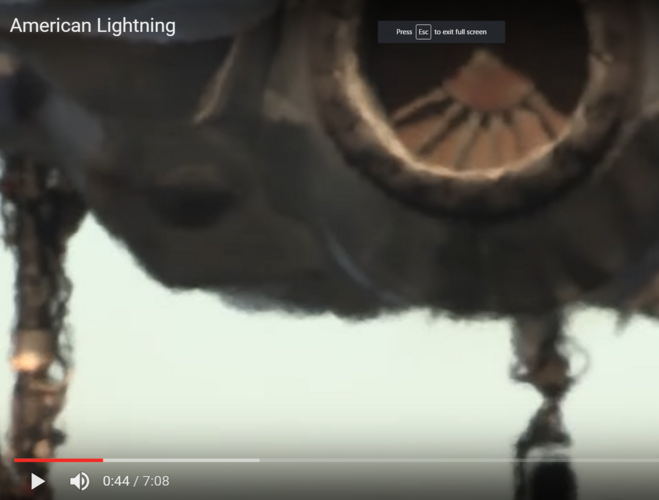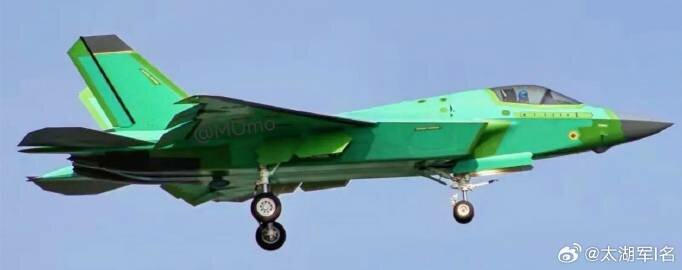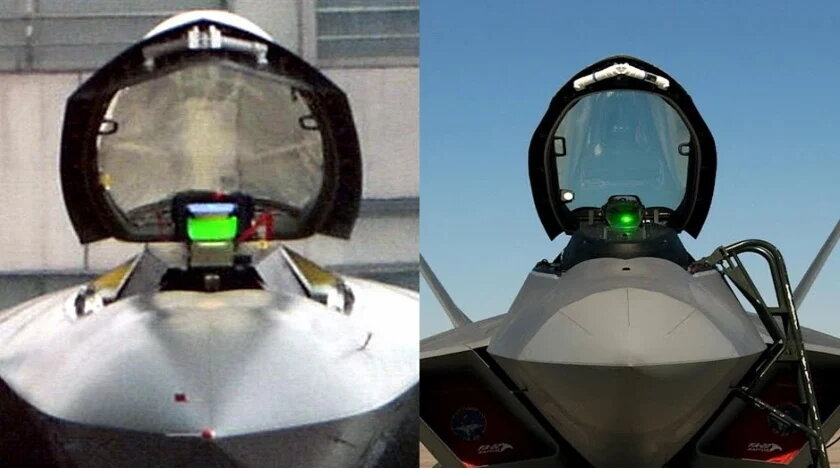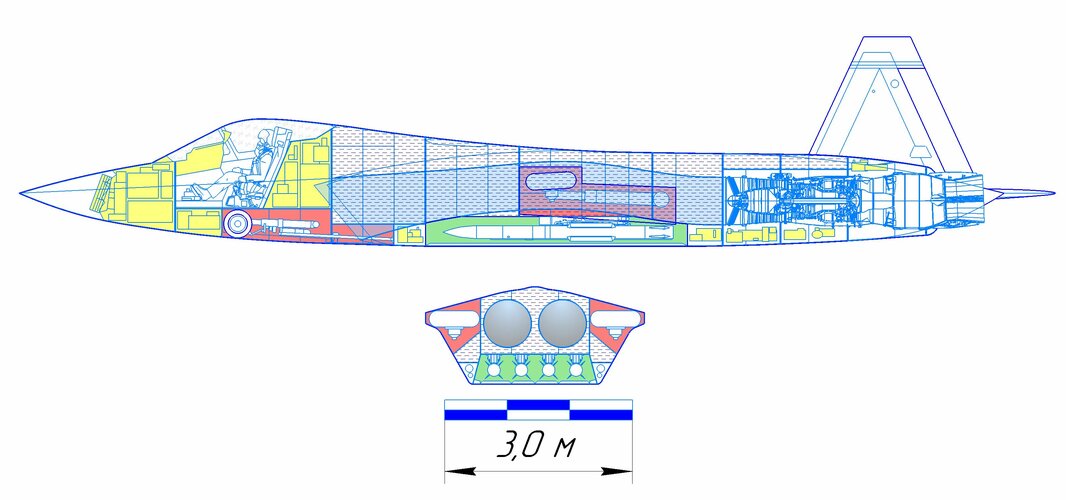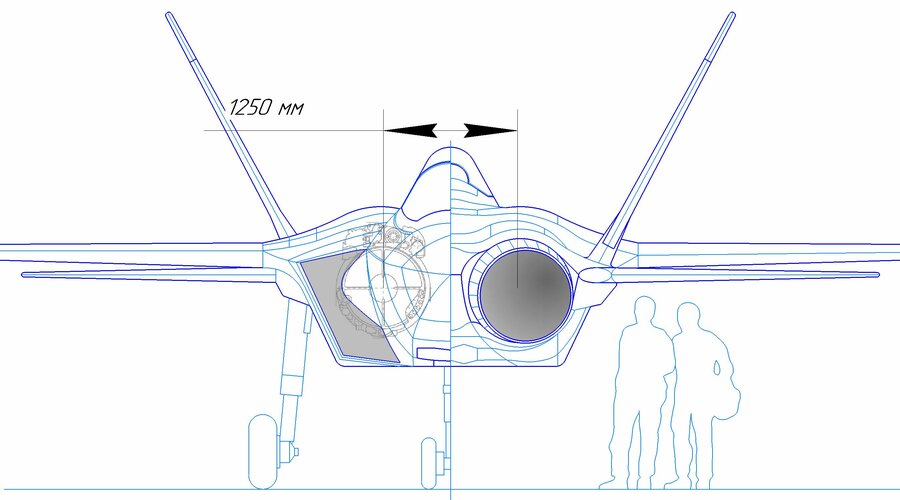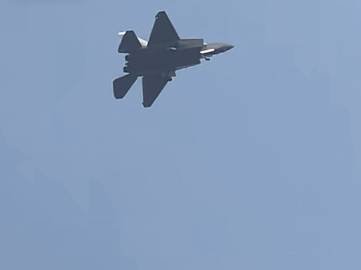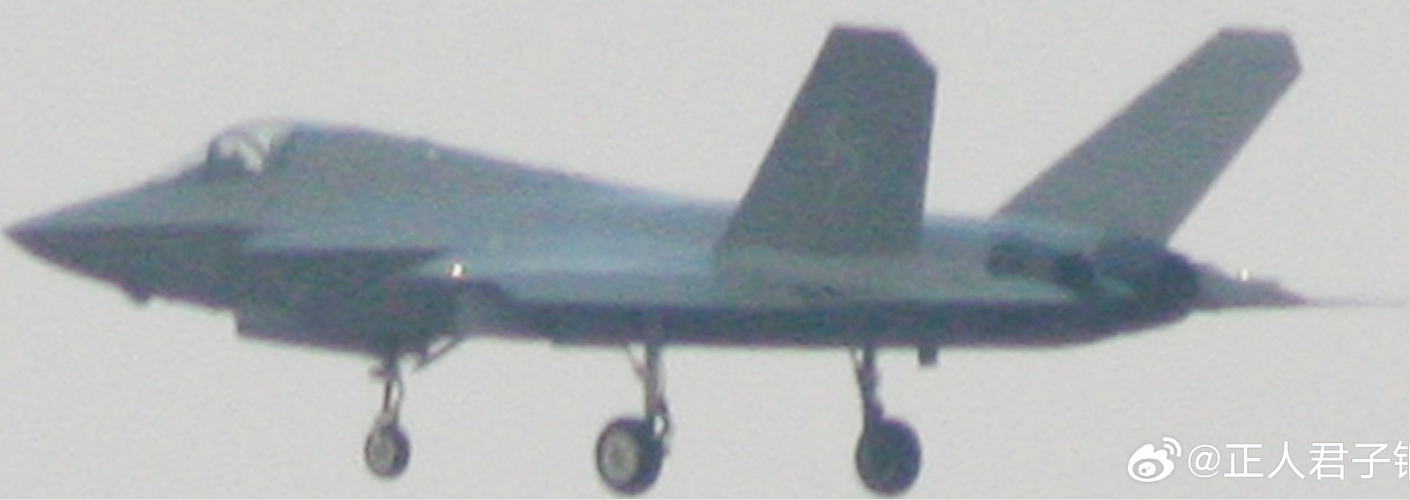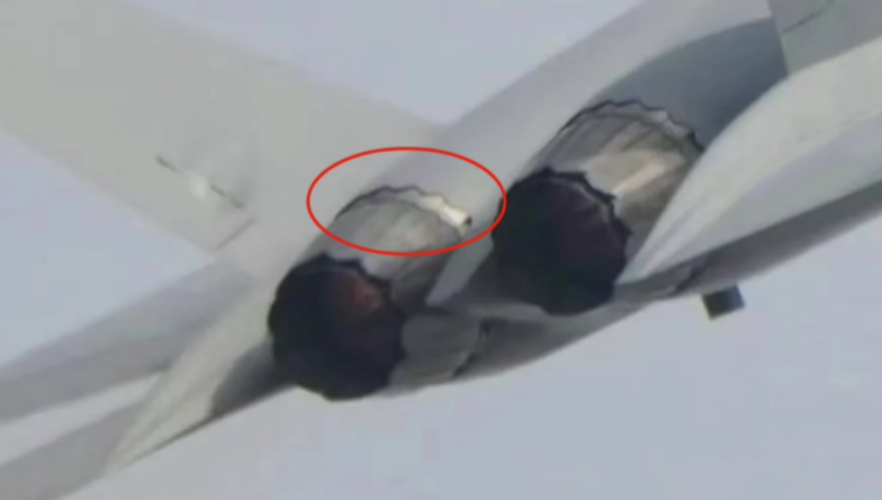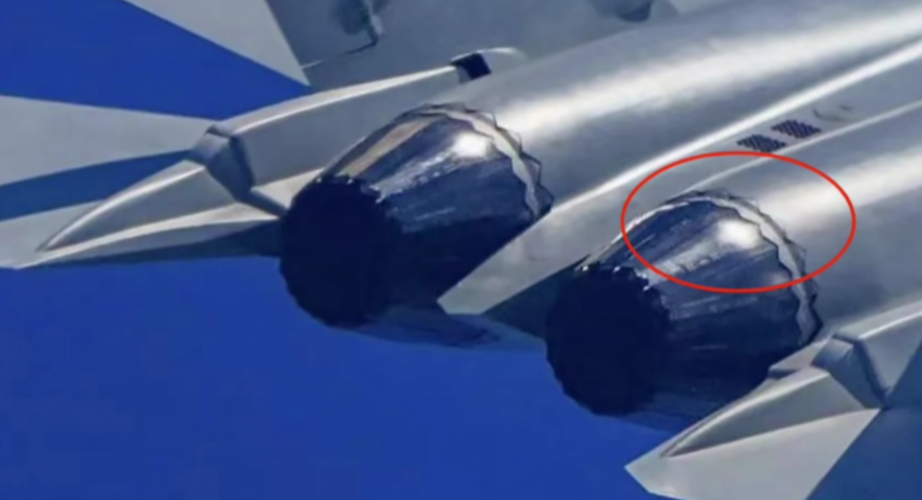You are using an out of date browser. It may not display this or other websites correctly.
You should upgrade or use an alternative browser.
You should upgrade or use an alternative browser.
Shenyang FC-31 demonstrators / J-35 naval fighter / J-35A land-based version
- Thread starter Foxglove
- Start date
- Joined
- 15 January 2021
- Messages
- 392
- Reaction score
- 1,426
I don’t see enough room for a full serpentine duct. It looks more like the SU-57 with some lateral offset inward, with the DSI bump blocking some of the engine view.That's assume the duct itself is a straight line from the inlet to the front of the engine face, which we of course know isn't given the case as we can see the geometry of the DSI to begin with.
Otherwise looking at something like F-22 or J-20 externally they would be assumed to have a straight path as well.
View attachment 749090
But nothing like F-22 or F-35 where the engine face is invisible from the outside.
I don’t see enough room for a full serpentine duct. It looks more like the SU-57 with some lateral offset inward, with the DSI bump blocking some of the engine view.
But nothing like F-22 or F-35 where the engine face is invisible from the outside.
I do agree that based on the lateral positioning of the engines relative to the centreline there's a little less horizontal room they have to play with than say J-20 and F-22 (F-35 is a bit unique given it's a single engine aircraft), but when looking at where the location of the engine face is probably at (particularly vertically relative to the air intake), and where the weapons bay is located, and considering the placement of the DSI bump, I'd be surprised if the engine face were visible from the usual frontal sector (basically from the intake it wound constrict and snake slightly downwards and laterally following the path of the DSI bump, before the second bend upwards and medially to meet the engine face).
Then again I'm sure it won't be too many years until we get a clear frontal aspect image of the aircraft in the way that we have for J-20, which would probably help to clarify the matter.
This is the best frontal aspect shot we have at this stage (obviously lacking details but shows the kind of relative spacing they have available to them)
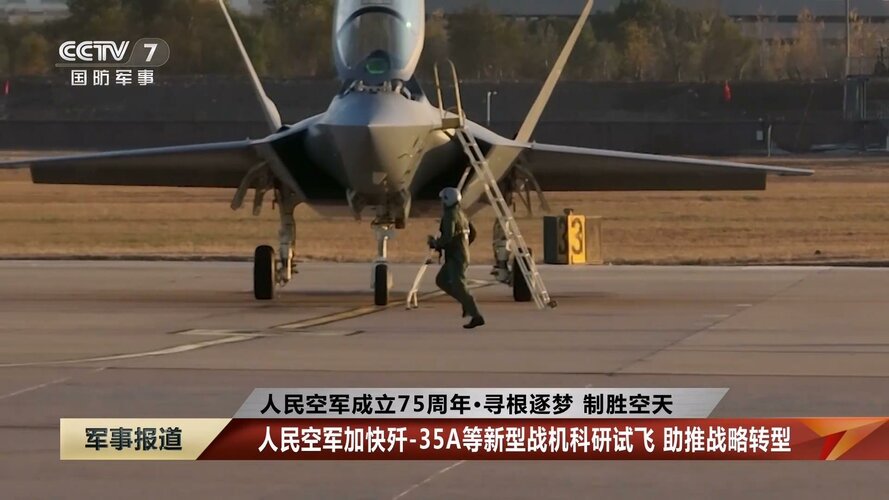
Last edited:
siegecrossbow
I really should change my personal text
- Joined
- 12 March 2012
- Messages
- 705
- Reaction score
- 2,097
I don’t see enough room for a full serpentine duct. It looks more like the SU-57 with some lateral offset inward, with the DSI bump blocking some of the engine view.
But nothing like F-22 or F-35 where the engine face is invisible from the outside.
Where do they fit the weapon bay if the duct is not curved?
It then appears to transition to the F35/KAAN style cockpit-canopy with the FC-31 3.0, where we see it open 'backwards'The first two iterations of the design it appears to have an F-22 style cockpit-canopy.
I absolutely agree with your counterargument - the US makes logical design decisions with their aircraft design, and these decisions to add things like EOTS/DAS would likely exist even in world where the LockMart didn't make the F-35 in 2006/before J-20 & J-35 etc. This design is no doubt indigneous, and my comment was intended to poke fun at the notion that a stealthy fighter aircraft wouldn't have s-ducts.Y'all are specifically choosing to ignore the fact that this aircraft existed for 12 years and kept evolving before it eventually evolved into a naval aviator.
-Since the US has had the most experience in designing so far, their designs obviously inspired everyone else's next generation aircraft and there's nothing wrong about it since this is the same kind of inspiration that the US also draws from others.-
While China was involved in industrial espionage as every country on the planet does, this is 100% an indigenous design (as anyone with a set of eyes and a brain can see from afar!).
View attachment 749093View attachment 749094
Your ignorance can no longer be tolerated as something unintended, this is starting to become malicious at this point...
You're welcome: https://chinese-military-aviation.blogspot.com/2012/07/fighters_18.html?m=1
@Deino @siegecrossbow @Blitzo
Scott Kenny
ACCESS: USAP
- Joined
- 15 May 2023
- Messages
- 11,184
- Reaction score
- 13,552
I mean, Russia keeps claiming that they have some weird grid thing in front of the engines of the Su57 that blocks radar, instead of just making an S-duct.my comment was intended to poke fun at the notion that a stealthy fighter aircraft wouldn't have s-ducts.
snne
ACCESS: Top Secret
- Joined
- 3 July 2022
- Messages
- 1,374
- Reaction score
- 4,443
Them shock diamonds...

I mean, F-22 and F-35 have it too. It's just that theirs are afterburner injectors that are meant to also act like blockers and are placed at the last stage of the engine whereas Su-57's are meant to divert waves from head on direction...
VS
Reading recommendation: https://basicsaboutaerodynamicsanda...2022/09/26/su-57-radar-scattering-simulation/ (a detailed open-source RCS estimation of Su-57 involving our very own @stealthflanker )


I mean, Russia keeps claiming that they have some weird grid thing in front of the engines of the Su57 that blocks radar, instead of just making an S-duct.
I mean, F-22 and F-35 have it too. It's just that theirs are afterburner injectors that are meant to also act like blockers and are placed at the last stage of the engine whereas Su-57's are meant to divert waves from head on direction...
VS

| 
| (cc: @stealthflanker)

|
Reading recommendation: https://basicsaboutaerodynamicsanda...2022/09/26/su-57-radar-scattering-simulation/ (a detailed open-source RCS estimation of Su-57 involving our very own @stealthflanker )

Last edited:
even in world where the LockMart didn't make the F-35 in 2006/before J-20 & J-35 etc.
But the X-35 did exist before 2006 so that no doubt did have an influence.
donnage99
ACCESS: Top Secret
- Joined
- 16 June 2008
- Messages
- 1,348
- Reaction score
- 830
US never revealed what was stolen in those hacks into the f-35 but edward snowden did.
"The Snowden files outline the scope of Chinese F-35 espionage efforts, which focused on acquiring the radar design (the number and types of modules), detailed engine schematics (methods for cooling gases, leading and trailing edge treatments, and aft deck heating contour maps) among other things."
The US cybersecurity and counter intelligence against China was an absolutely mess to largely not fault of their own during the early 2000s. At the time, I remember several officials ringing the alarming bells once in a while over the fact that most resources were dedicated to the war on terror and there's not enough resources/funding to secure our data from near peer threats.
Regardless, I think it's wise to refrain from typing "copy" every time we see some sort of obvious similarities to the naked eyes. It doesn't add anything to the discussion and technical understanding we all pursue and it doesn't stand on any ground of evidence unless forensic analysis that show explicit similarities such as inlet ducts specific schematics, composition and placement of different materials to suppress radar returns or infrared signature.
New Snowden Documents Reveal Chinese Behind F-35 Hack
Experts have long argued that China has copied the F-35 design for its own fighter jets. Is this the proof?
thediplomat.com
"The Snowden files outline the scope of Chinese F-35 espionage efforts, which focused on acquiring the radar design (the number and types of modules), detailed engine schematics (methods for cooling gases, leading and trailing edge treatments, and aft deck heating contour maps) among other things."
The US cybersecurity and counter intelligence against China was an absolutely mess to largely not fault of their own during the early 2000s. At the time, I remember several officials ringing the alarming bells once in a while over the fact that most resources were dedicated to the war on terror and there's not enough resources/funding to secure our data from near peer threats.
Regardless, I think it's wise to refrain from typing "copy" every time we see some sort of obvious similarities to the naked eyes. It doesn't add anything to the discussion and technical understanding we all pursue and it doesn't stand on any ground of evidence unless forensic analysis that show explicit similarities such as inlet ducts specific schematics, composition and placement of different materials to suppress radar returns or infrared signature.
US never revealed what was stolen in those hacks into the f-35 but edward snowden did.
New Snowden Documents Reveal Chinese Behind F-35 Hack
Experts have long argued that China has copied the F-35 design for its own fighter jets. Is this the proof?thediplomat.com
"The Snowden files outline the scope of Chinese F-35 espionage efforts, which focused on acquiring the radar design (the number and types of modules), detailed engine schematics (methods for cooling gases, leading and trailing edge treatments, and aft deck heating contour maps) among other things."
The US cybersecurity and counter intelligence against China was an absolutely mess to largely not fault of their own during the early 2000s. At the time, I remember several officials ringing the alarming bells once in a while over the fact that most resources were dedicated to the war on terror and there's not enough resources/funding to secure our data from near peer threats.
Regardless, I think it's wise to refrain from typing "copy" every time we see some sort of obvious similarities to the naked eyes. It doesn't add anything to the discussion and technical understanding we all pursue and it doesn't stand on any ground of evidence unless forensic analysis that show explicit similarities such as inlet ducts specific schematics, composition and placement of different materials to suppress radar returns or infrared signature.
My personal feeling is there is probably a good chance that the development of various PRC systems, including J-35A, benefitted from cyber espionage, however I think people arguing that on the basis of overall/gross configuration of an airframe are not being very logical and probably underestimating how easy it is to actually produce an aircraft, and overestimating the importance of an aircraft's "design".
Instead, areas that may have actually seen benefits from cyberespionage include:
- providing a base of knowledge to advance further research and development overall
- providing intelligence with which to "tune" and inform their own systems to counter
- if direct "copying" of subsystems or technology occurred, it is probably less the overall external geometry of the aircraft and more informing specific internal subsystems or even coding
- Joined
- 15 January 2021
- Messages
- 392
- Reaction score
- 1,426
Nicely defined shock diamonds, but they are more closely spaced than you see on the F-22 and F-35, implying lower exhaust velocity. Probably running a fan pressure ratio in the 3:0-3.5, similar to the F100/F110 generation.Them shock diamonds...


Pakistan plans to purchase 40 Chinese J-35 stealth fighter jets - Times of India
Pakistan News: Pakistan plans to acquire 40 J-35 stealth fighters from China, marking the first export of Beijing’s fifth-generation jets to a foreign ally. The J-35
snne
ACCESS: Top Secret
- Joined
- 3 July 2022
- Messages
- 1,374
- Reaction score
- 4,443
To everyone: Please make it a habit of yours to only share credible news...
Pakistan plans to purchase 40 Chinese J-35 stealth fighter jets - Times of India
Pakistan News: Pakistan plans to acquire 40 J-35 stealth fighters from China, marking the first export of Beijing’s fifth-generation jets to a foreign ally. The J-35timesofindia.indiatimes.com
Tomboy
ACCESS: Confidential
- Joined
- 4 January 2025
- Messages
- 79
- Reaction score
- 300
Newer aircrafts seem to use a 5 digit system, ie. 31001 for the first FC-31 demonstrator, so basically it would mean the first airframe of the 2nd variant("0"th would be the first variant or technology demonstrator) of the J-36The serial number on the plane in the videos is 36011.
Which by your explanation is the 11th airframe of the 0th variant of the J36.
- Joined
- 28 January 2008
- Messages
- 992
- Reaction score
- 2,118
Really long flaperons, I'm surprised they did not split these surfaces due to the wing span.Nicely defined shock diamonds, but they are more closely spaced than you see on the F-22 and F-35, implying lower exhaust velocity. Probably running a fan pressure ratio in the 3:0-3.5, similar to the F100/F110 generation.
siegecrossbow
I really should change my personal text
- Joined
- 12 March 2012
- Messages
- 705
- Reaction score
- 2,097
- Joined
- 27 December 2005
- Messages
- 17,693
- Reaction score
- 25,977
Oh that old thing. So 2024.
ROFL!To seal the frontal opening of the canopy better (I believe) and thus reduce it's impact on the most critical sector of the RCS. At least this is the main reason why Kaan also has it.
View attachment 748997
It's also easier to remove the seat and do maintenance this way. (Which might be a big plus when you're in the hangar of a CV.)
- Joined
- 2 January 2006
- Messages
- 3,803
- Reaction score
- 4,943
A great image of a naval J-35 in green primer!
Not sure if it is an older image released just now showing one of the prototypes or even a recent one suggesting a LRIP aircraft.
EDIT/Update: seems to be the first prototype due to the non-retractable fixed Luneburg-lense.
(Image via @太湖军I名 from Weibo)

Not sure if it is an older image released just now showing one of the prototypes or even a recent one suggesting a LRIP aircraft.
EDIT/Update: seems to be the first prototype due to the non-retractable fixed Luneburg-lense.
(Image via @太湖军I名 from Weibo)
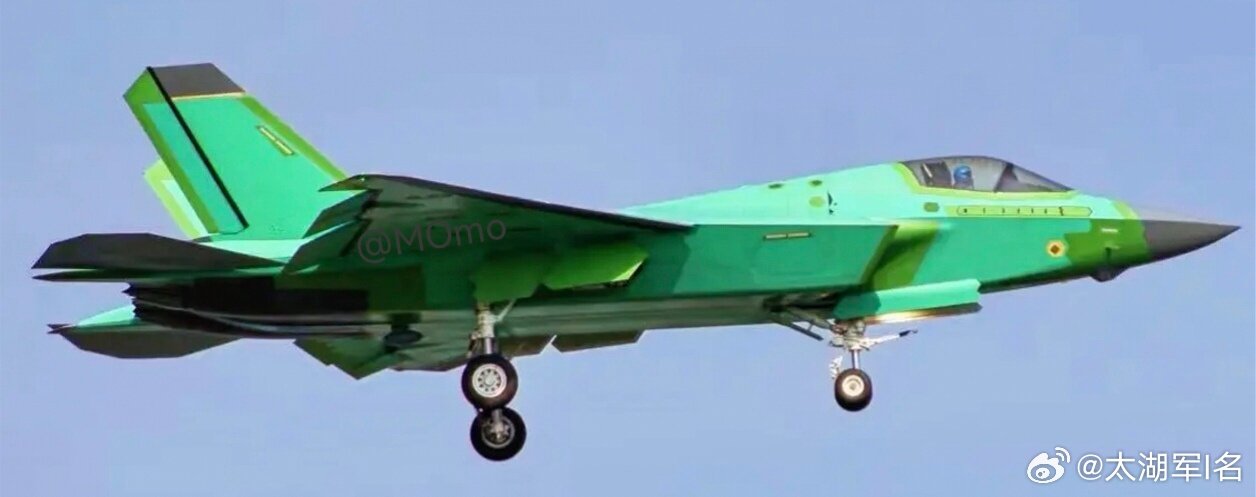
Last edited:
Why is there this sort of suspension of disbelief that these aircraft features true s-ducts. I've seen this happening with the J-36 too with some forum members on cough f-16.net whole heartedly believing that the 'J-36' has straight ducts and isn't stealthy.I don’t see enough room for a full serpentine duct. It looks more like the SU-57 with some lateral offset inward, with the DSI bump blocking some of the engine view.
But nothing like F-22 or F-35 where the engine face is invisible from the outside.
Despite the slim profile, the J-35 here has most likely an overall deeper bay than the J-20 due to advances in optimizing the internal structure, over the course of it's development time.
"Nothing like the F-22 or F-35 where the engine face is invisible from the outside"
What even leads you to this statement. Why is it that the J-35 whose layout is much much more similar to the F-22 than the su-57 is more likely to have a semi s-duct like the su57 and not the f22.
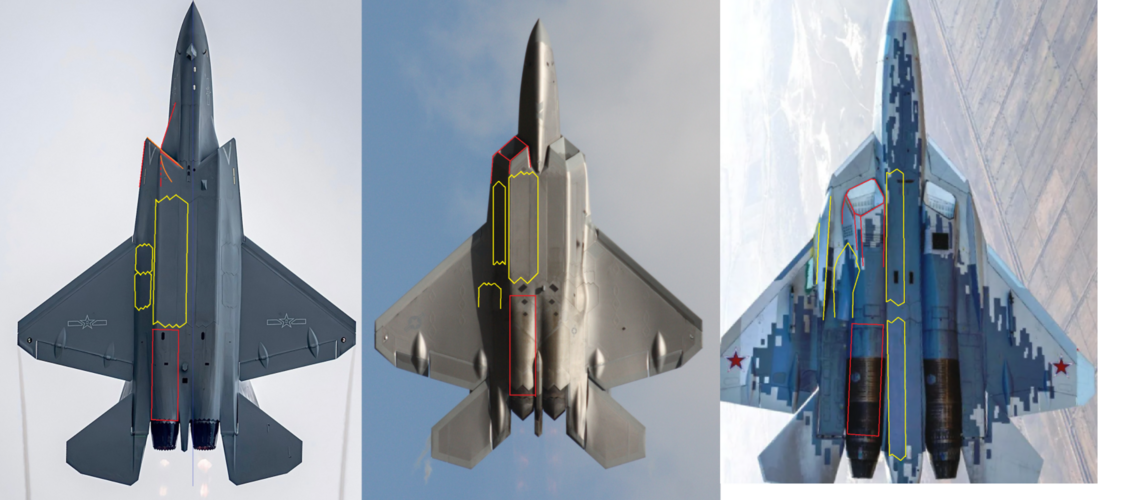
*Images not to scale*
The reason why the Su-57 only has partial s-ducts is because the Sukhoi design bureau made it so the engines are in separate housings from the main fuselage, this gave the su57 an advantage where they could have massive long and deeper bays in the center of the fuselage, however this decreased the amount of room that allowed the ducts to curve.
Both the F-22 and the J-35 shown in the picture above have their engines right behind their weapons bays. The ducting becomes extremely complicated due to the amount of structural elements that need to be bypassed in order to get the air into the engines. You're telling me that when you look at these images, the J-35 air ducts are more likely to be similar to the SU-57 design on the right than the F-22 in the middle? Where do you see enough room for the F-22 but not for the J-35 for serpentine intakes?
The J-35 also has smaller engines with allows for smaller ducting than the F119 and the WS-10/WS-15 on the J20 not pictured here. This also allowed designers to flatten the ducting more and slim the profile of the J-35 despite it most likely featuring a deeper weapons bay than the J-20, and likely the F-22 as well.
*Images below from Alfa_Particle on SDF
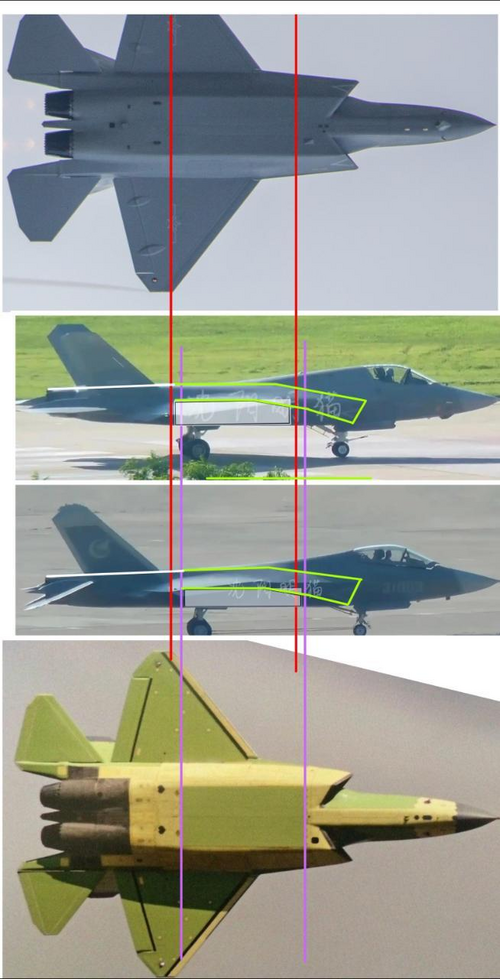
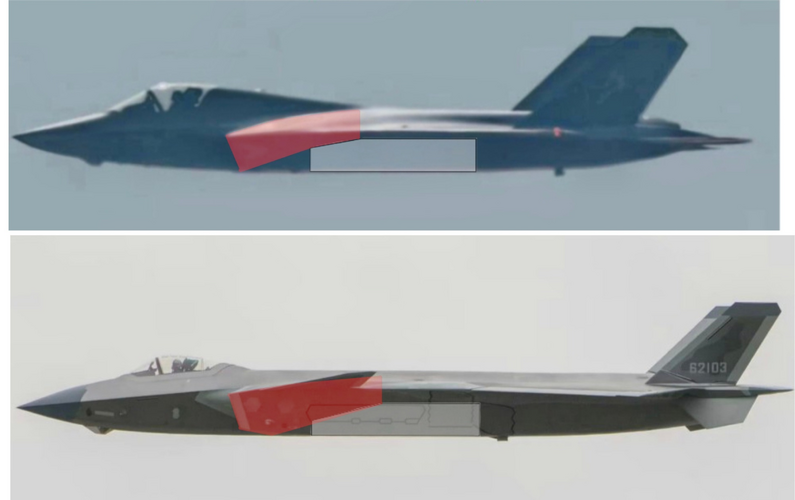
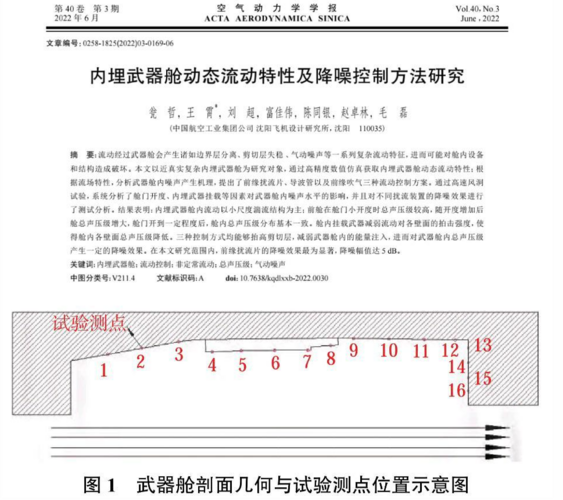
Last edited:
No he's not? And the J-20 is moving away from it too.
- Joined
- 15 January 2021
- Messages
- 392
- Reaction score
- 1,426
You may be right. On the F-22 there is as much lateral displacement of the inlet duct as there is vertical. You can see this in the top view where the zig-zag bleed doors are centered over the ducts.Why is there this sort of suspension of disbelief that these aircraft features true s-ducts. I've seen this happening with the J-36 too with some forum members on cough f-16.net whole heartedly believing that the 'J-36' has straight ducts and isn't stealthy.
Despite the slim profile, the J-35 here has most likely an overall deeper bay than the J-20 due to advances in optimizing the internal structure, over the course of it's development time.
"Nothing like the F-22 or F-35 where the engine face is invisible from the outside"
What even leads you to this statement. Why is it that the J-35 whose layout is much much more similar to the F-22 than the su-57 is more likely to have a semi s-duct like the su57 and not the f22.
View attachment 759397
*Images not to scale*
The reason why the Su-57 only has partial s-ducts is because the Sukhoi design bureau made it so the engines are in separate housings from the main fuselage, this gave the su57 an advantage where they could have massive long and deeper bays in the center of the fuselage, however this decreased the amount of room that allowed the ducts to curve.
Both the F-22 and the J-35 shown in the picture above have their engines right behind their weapons bays. The ducting becomes extremely complicated due to the amount of structural elements that need to be bypassed in order to get the air into the engines. You're telling me that when you look at these images, the J-35 air ducts are more likely to be similar to the SU-57 design on the right than the F-22 in the middle? Where do you see enough room for the F-22 but not for the J-35 for serpentine intakes?
The J-35 also has smaller engines with allows for smaller ducting than the F119 and the WS-10/WS-15 on the J20 not pictured here. This also allowed designers to flatten the ducting more and slim the profile of the J-35 despite it most likely featuring a deeper weapons bay than the J-20, and likely the F-22 as well.
*Images below from Alfa_Particle on SDF
View attachment 759398
View attachment 759399View attachment 759400
I didn’t see enough volume in the J-35 fuselage for this feature, but you make a valid point about the smaller duct area for the smaller, lower airflow engines.
- Joined
- 15 January 2021
- Messages
- 392
- Reaction score
- 1,426
If your duct illustration is accurate, it does not provide complete blockage of direct line of sight to the front face of the engine. Better than the Su-57, not as good as the F-22 and F-35. Is it sufficient to block the radar returns from the engine ? I don’t know.
His illustrations aside, how about these images. I'm not sure what sources he used to draw his blueprints. But these should show theIf your duct illustration is accurate, it does not provide complete blockage of direct line of sight to the front face of the engine. Better than the Su-57, not as good as the F-22 and F-35. Is it sufficient to block the radar returns from the engine ? I don’t know.
ducting of the FC-31.

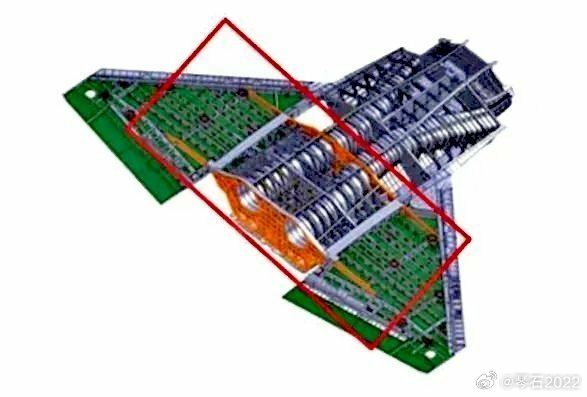
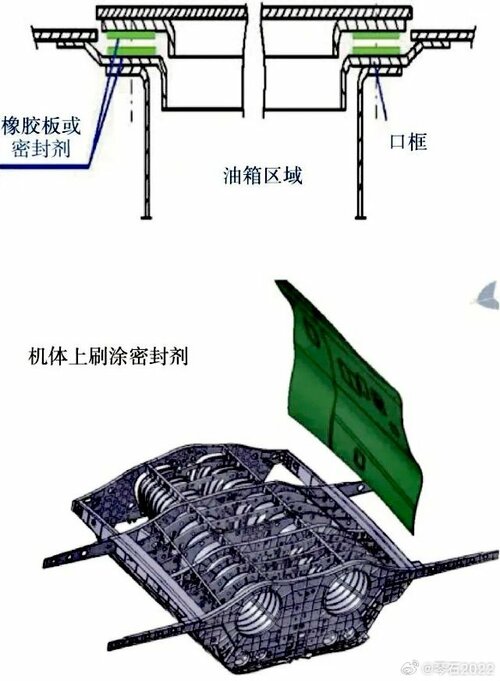
Although it would be unknown how much of the internal layout has changed since it's progression since then.
- Joined
- 15 January 2021
- Messages
- 392
- Reaction score
- 1,426
If accurate, the lateral displacement shown in the first illustration would be close to complete LOS blockage from a frontal view.
siegecrossbow
I really should change my personal text
- Joined
- 12 March 2012
- Messages
- 705
- Reaction score
- 2,097
BLACK_MAMBA
ACCESS: Secret
- Joined
- 17 July 2019
- Messages
- 382
- Reaction score
- 876
F-23A EMD drawings also don't have complete engine face blockage and based on public statements they were very confident about their RCS numbers compared to the Lockheed design.If your duct illustration is accurate, it does not provide complete blockage of direct line of sight to the front face of the engine. Better than the Su-57, not as good as the F-22 and F-35. Is it sufficient to block the radar returns from the engine ? I don’t know.
siegecrossbow
I really should change my personal text
- Joined
- 12 March 2012
- Messages
- 705
- Reaction score
- 2,097
But can we be sure these are new ones "rolling off the assembly line" or is this not more likely just one of those seen at Zhuhai since they (this one at least) has the same 75-marking on its tails??
View attachment 764334
They are different birds.
alberchico
I really should change my personal text
- Joined
- 14 January 2014
- Messages
- 704
- Reaction score
- 1,506
I wonder which foreign intelligence agency purchased secrets and how badly is this aircraft compromised ? If this story is true, it would be a huge black eye for Chinas's military. Any adversary that obtained the technical details the FC-31 would also be able to ascertain how stealthy and capable the J-20 would be.
- Joined
- 2 January 2006
- Messages
- 3,803
- Reaction score
- 4,943
They are different birds.
May I ask you for an explanation? Given that it spots the "75" on its tail and is overall that much blurry I'm not sure if this conclusion is possible ??
siegecrossbow
I really should change my personal text
- Joined
- 12 March 2012
- Messages
- 705
- Reaction score
- 2,097
May I ask you for an explanation? Given that it spots the "75" on its tail and is overall that much blurry I'm not sure if this conclusion is possible ??
I meant the one in my photo is different from yours.
- Joined
- 2 January 2006
- Messages
- 3,803
- Reaction score
- 4,943
I meant the one in my photo is different from yours.
Really?.. I thought both images share the same "new" one from that recent sighting!
But again, yours is so small and blurry, why do you think it is a new one?
Similar threads
-
-
-
-
Shenyang Jianjiji-11 / J-11 Lightweight Fighter
- Started by Deino
- Replies: 11
-


